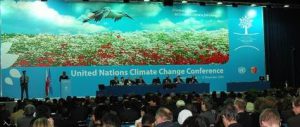Recent global warming negotiations in Bonn, Germany, began with loud applause, as United States special climate envoy Todd Stern announced that the US was back. They ended with the reality of the work that needs to be done over the next eight months to ensure a strong agreement at the climate conference in Copenhagen, Denmark.
There are four key elements that are essential to getting a robust agreement:
• Strong leadership from developed countries, with firm and aggressive emissions reduction caps;
• Developing countries willing to undertake significant emissions reductions on their own, with the structure and size of performance-based incentives from developed countries encouraging greater developing country emissions reductions;
• Measures to reverse the rate of deforestation;
• Support for adaptation to the impacts of climate change in the most vulnerable countries.
There is a lot to be done. But there are hints that, with strong leadership, the pieces can fall into place.
First, it became clear at the meeting that the United States has re-committed to the process.“My team and I came here determined to make up for lost time,” said special envoy Todd Stern. “America is now once again strongly committed to developing a global response to climate change.” These remarks provided a strong signal of US president Barack Obama’s commitment to re-engage the country in international negotiations.
Stern’s speech reaffirmed two key pieces that the United States will be bringing to the negotiations:
• Firm limits on US global warming pollution in the near-term, and annual declining targets through 2050;
• Significant funds" to support developing countries through performance-based incentives for emissions reductions and adaptation assistance.
Only a day after Todd Stern’s remarks, the sprint began to pass a clean energy and global warming bill in the United States. Chairman Henry Waxman and Ed Markey from the US House of Representatives released a discussion draft which contains a number of key tools to help secure a strong international agreement in Copenhagen. These include:
• Designing international carbon market access rules to encourage unilateral actions from developing countries before they can sell credits into the US market;
• Providing incentives to achieve emissions reductions in international deforestation emissions; Creating incentives for exporting clean energy technologies to developing countries that take on their own commitment;
• Supporting developing countries to adapt to global warming and reduce national security threats.
How these provisions play out in the US debate (and the discussion in other capitals around the world) will be a preview of what can be agreed in Copenhagen, as these are crucial elements that countries will have to bring to a new agreement.
There was also a lot of frank conversation at Bonn about the development of “low-carbon strategies” by developing countries. The specifics of these strategies are still under discussion, but they essentially outline medium-term strategies for a carbon-constrained world, where development objectives are met. Some actions would be implemented on their own, and some achieved with assistance from the developed world.
Under these strategies, developing countries could commit to reduce emissions in key sectors of the economy and receive incentives for further action through the carbon market and technology agreements. This would mean evolving from "offsets", toward sectoral approaches for developing countries.
Unfortunately, this aspect of the discussion is currently mired in a “chicken and egg” scenario — with developing countries not willing to show what actions they can do until the developed countries detail what assistance they can provide; and developed countries not outlining what assistance they will provide until they know what actions the developing countries will undertake. Resolving this will likely come down to a simultaneous negotiation, where both sides have to “show their cards” at the same time.
Climate-change negotiators will need their leaders to point them in the right direction if they are going to get a strong agreement. There are a lot of very difficult political decisions that will need to be agreed before and during the Copenhagen meeting, and these will require decisions “above the pay grade” of the negotiators. A number of venues are emerging for these leaders to start to send the signal that there is space for a strong agreement: that countries are ready to set aside their differences and get into the business of designing workable strategies. World leaders recently met at the Major Economies Forum and there will be a number of key bilateral engagements, such as the US-China dialogue. At the recent G20 meeting in London the leaders of the largest 20 economies in the world (the world’s biggest emitters) committed to “reach agreement at the UN Climate Change conference in Copenhagen in December 2009.”
We will need to quickly get past posturing and into structuring a strong agreement. The work toward a strong international response to global warming will be focused toward a meeting back in Bonn in June. At this meeting, countries will have to start to “show their cards” with a draft negotiating text on which to focus the negotiations.
There is still a lot of work to be done, but some encouraging signs have emerged.
Jake Schmidt is International Climate Policy Director at the Natural Resources Defense Council.
Homepage photo from the U.S. Department of State


